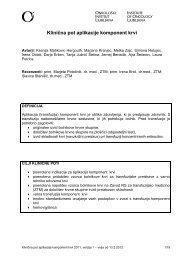Create successful ePaper yourself
Turn your PDF publications into a flip-book with our unique Google optimized e-Paper software.
Electrogene therapy with p53 alone and in combination<br />
with electrochemotherapy using cisplatin in treatment<br />
of murine sarcomas<br />
Alenka Gro{el, Maja ^ema`ar, Simona Kranjc, Suzana Mesojednik,<br />
Gregor Tev`, Gregor Ser{a<br />
Dept. of Experimental Oncology, Institute of Oncology, Zalo{ka 2,<br />
SI-1000 Ljubljana, Slovenia<br />
Electroporation is an established method for the delivery of molecules into<br />
the cells. Biomedical application of electroporation in vivo is either delivery of<br />
chemotherapeutic drugs - electrochemotherapy or DNA - electrically assisted gene<br />
delivery or electrogene therapy. p53 plays crucial role in diverse cellular pathways<br />
in response to DNA damage, one of them being apoptotic cell death. Cisplatin, a<br />
commonly used chemotherapeutic agent, causes tumor cell death by producing<br />
DNA damage and generating reactive oxygen intermediates. Our hypothesis was<br />
that increased DNA damage due to increased cellular concentration of cisplatin by<br />
electroporation e.g. electrochemotherapy would result in at least additive antitumor<br />
effect in p53 electrogene therapy pre-treated tumors.<br />
Aim of our study was to evaluate feasibility and therapeutic potential of electrogene<br />
therapy with p53 alone or combined with electrochemotherapy using cisplatin in<br />
two murine sarcomas with different p53 status.<br />
In order to demonstrate feasibility and therapeutic potential murine subcutaneous<br />
sarcomas (LPB and SA-1) were treated either with plasmid DNA, cisplatin or<br />
electroporation and combinations of these treatments. Status of p53 in the tumors was<br />
determined immunohistochemically, transfection efficacy by luciferase expression in<br />
the tumors and antitumor effectiveness of the treatments by tumor growth delay and<br />
determination of tumor free animals.<br />
Antitumor effectiveness of three consecutive electrogene treatments with p53 was<br />
dependent on the status of p53 being more effective in wild type LPB tumor than<br />
in mutated SA-1 tumor. Pretreatment of tumors with electrogene therapy with p53<br />
enhanced chemosensitivity of both tumor models treated by electrochemotherapy<br />
with cisplatin. After only one treatment in LPB tumor model, tumor growth delay<br />
was prolonged for 10 days in combined treatment group compared to electrogene<br />
therapy with p53 or electrochemotherapy with cisplatin alone, whereas in SA-1<br />
tumors this treatment combination resulted in 32% of cured animals.<br />
In conclusion, results of our study show that electrogene therapy with p53 alone<br />
or combined with electrochemotherapy is feasible and effective in treatment of<br />
tumors. The combination of electrogene therapy and electrochemotherapy after<br />
only one treatment resulted beside prolonged tumor growth delay also in tumor<br />
free animals.<br />
p1283

















